BBC Mundo, Panama
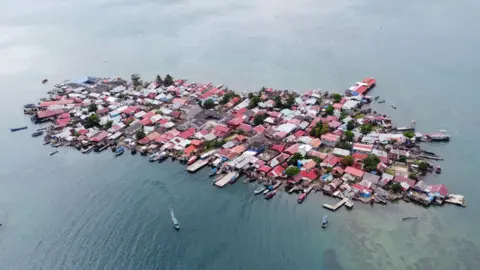 BBC
BBC“If the island sinks, I’ll sink with it,” Delfino Davies says, his smile not fading for a second.
There may be silence, apart from the swish of his broom throughout the ground of the small museum he runs documenting the lifetime of his group in Panama, the Guna.
“Earlier than, you may hear youngsters shouting… music all over the place, neighbours arguing,” he says, “however now all of the sounds have gone”.
His group, dwelling on the tiny low-lying island of Gardi Sugdub, is the primary in Panama to be relocated due to local weather change.
The federal government has mentioned they face “imminent threat” from rising sea ranges, which scientists say are more likely to render the island uninhabitable by 2050.
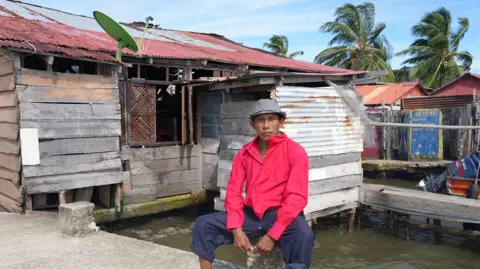
In June final 12 months, a lot of the residents deserted this cramped jumble of picket and tin houses for rows of neat prefabricated homes on the mainland.
The relocation has been praised by some as a mannequin for different teams worldwide whose houses are below risk, besides, it has divided the group.
“My father, my brother, my sisters-in-law and my pals are gone,” says Delfino. “Typically the youngsters whose households have stayed cry, questioning the place their pals have gone, he says.
Home after home is padlocked. About 1,000 folks left, whereas about 100 stayed – some as a result of there was not sufficient room within the new settlement. Others, like Delfino, usually are not absolutely satisfied local weather change is a risk, or just didn’t need to go away.
He says he needs to remain near the ocean, the place he can fish. “The folks that lose their custom lose their soul. The essence of our tradition is on the islands,” he provides.
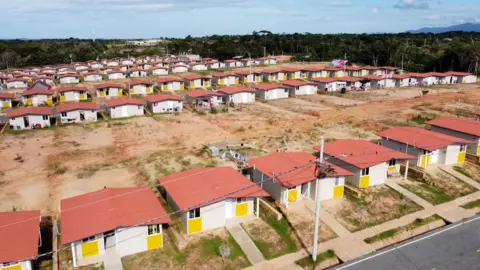
The Guna have lived on Gardi Sugdub because the nineteenth Century, and even longer on different islands on this archipelago off Panama’s northern coast. They fled from the mainland to flee Spanish conquistadors and, later, epidemics and battle with different indigenous teams.
They’re identified for his or her garments known as “molas”, embellished with vibrant designs.
The Guna at present inhabit greater than 40 different islands. Steve Paton, a scientist on the Smithsonian Tropical Analysis Institute in Panama, says it’s “virtually a certainty” that the majority, if not all, of the islands will likely be submerged earlier than the tip of the century.
As local weather change causes the Earth to warmth up, sea ranges are rising as glaciers and ice sheets soften and seawater expands because it warms.
Scientists warn that lots of of tens of millions of individuals dwelling in coastal areas around the globe may very well be in danger by the tip of the century.
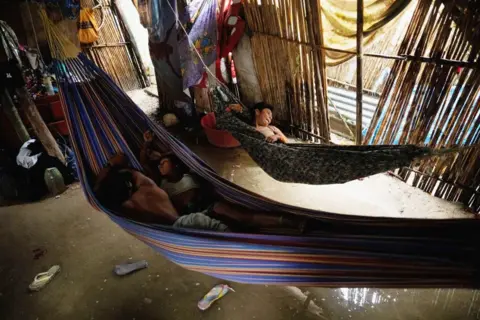 Getty Pictures
Getty PicturesOn Gardi Sugdub, waves whipped up in the course of the wet season wash into houses, lapping beneath the hammocks the place households sleep.
Mr Paton says, “it is extremely unlikely that the island will likely be liveable by 2050, based mostly on present and projected charges of sea stage rise”.
Nevertheless, the primary discussions about relocation started, greater than a decade in the past, due to inhabitants development, not local weather change.
The island is simply 400m lengthy and 150m large. Some residents see overcrowding because the extra urgent downside. However others, like Magdalena Martínez, concern the rising sea:
“Yearly, we noticed the tides had been greater,” she says. “We could not prepare dinner on our stoves and it was all the time flooded… so we mentioned ‘now we have to get out of right here’.”
Magdalena was amongst those that clambered into motor boats and picket canoes final June, sure for brand spanking new houses.
“I introduced simply my garments and a few kitchen utensils,” she says. “You are feeling like you might be leaving items of your life on the island.”
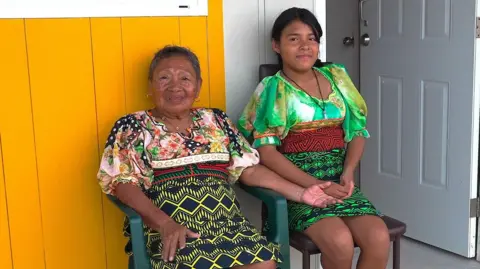
The brand new group, Isberyala, is – climate allowing – simply quarter-hour by boat, adopted by a five-minute drive, from Gardi Sugdub. However it seems like one other world.
Similar white and yellow houses line tarmacked roads.
Magdalena’s eyes mild up as she reveals off the “little home” the place she lives together with her 14-year-old granddaughter Bianca and her canine.
Every home has a small space of land behind it – a luxurious not accessible on the island. “I need to plant yucca, tomatoes, bananas, mangoes and pineapples,” she enthuses.
“It’s fairly unhappy to go away a spot you’ve got been in for therefore lengthy. You miss your mates, the streets the place you lived, being so near the ocean,” she says.
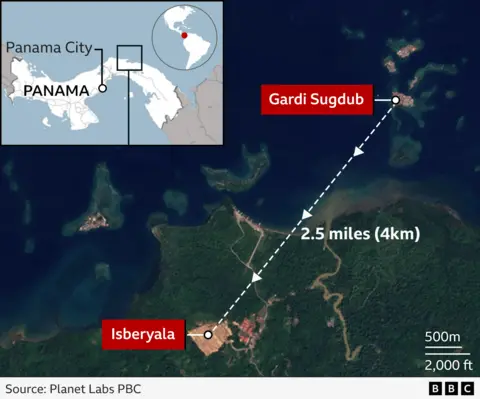
Isberyala was constructed with $15m (£12m) from the Panamanian authorities and extra funding from the Inter-American Growth Financial institution.
In its new assembly home, which is roofed with branches and leaves within the conventional type, waits Tito López, the group’s sayla – or chief.
“My id and my tradition aren’t going to alter, it is simply the homes which have modified,” he says.
He’s mendacity in a hammock, and explains that so long as the hammock retains its place in Guna tradition, “the guts of the Guna folks will likely be alive”.
When a Guna dies, they lie for a day of their hammock for household and pals to go to. It’s then buried subsequent to them.
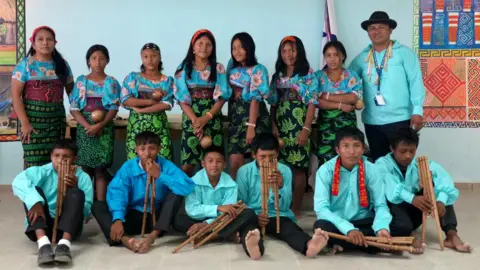
Within the state-of-the-art new college, college students aged 12 and 13 are rehearsing Guna music and dances. Boys in shiny shirts play pan pipes, whereas women sporting molas shake maracas.
The cramped college on the island has closed now, and college students whose households stayed there journey every day to the brand new constructing with its computer systems, sports activities fields and library.
Magdalena says circumstances in Isberyala are higher than on the island, the place she says that they had solely 4 hours of electrical energy a day and needed to fetch consuming water by boat from a river on the mainland.
In Isberyala, the ability provide is fixed, however the water – pumped from wells close by – is simply switched on for a number of hours a day. The system has at instances damaged down for days at a time.
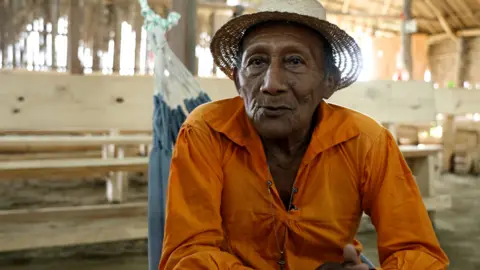
Additionally, there is no such thing as a healthcare but. One other resident, Yanisela Vallarino, says one night her younger daughter was unwell and he or she needed to prepare transport again to the island late at night time to see a health care provider.
Panamanian authorities instructed the BBC that development of a hospital in Isberyala stalled a decade in the past over lack of funding. However they mentioned they hoped to revive the plan this 12 months, and had been assessing tips on how to create area for remaining residents to maneuver from the island.
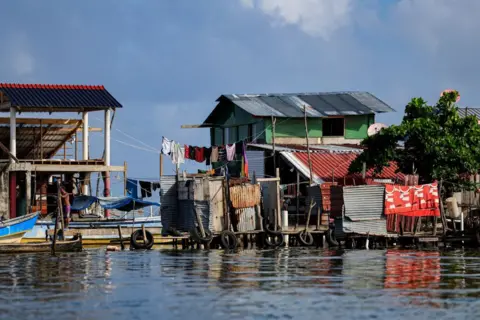 Getty Pictures
Getty PicturesYanisela is delighted that she is now in a position to attend night lessons within the new college, however she nonetheless returns to the island regularly.
“I am not used to it but. And I miss my home,” she says.
Communities around the globe will likely be “impressed” by the way in which the residents of Gardi Sugdub have confronted their state of affairs, says Erica Bower, a researcher on local weather displacement at Human Rights Watch.
“We have to be taught from these early instances to know what success even seems to be like,” she says.
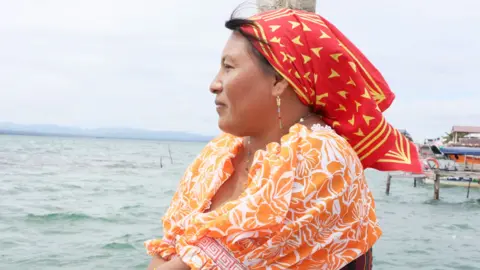
As afternoon arrives, the varsity actions give solution to the shouts and scuffles of soccer, basketball and volleyball.
“I desire this place to the island as a result of now we have more room to play,” says eight-year-old Jerson, earlier than diving for a soccer.
Magdalena sits together with her granddaughter, educating her to stitch molas.
“It is arduous for her, however I do know she’s going to be taught. Our distinctive methods cannot be misplaced,” says Magdalena.
Requested what she misses concerning the island, she replies: “I want we had been all right here.”

